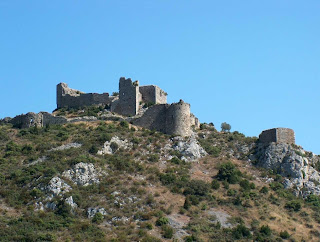I made a small booklet with many great photos and some historical text that i found on the net about each of these castle,hope that you will like it.
Link to download :
http://www.mediafire.com/?hbaay5a788pn2h3
Cathar Castles
A short events recall....
During the XIIth century, in the South of France, a christian religion different from catholicism developped: catharism .
This new belief based on christianity but very critical towards catholocism was quickly spread to all Occitany. To thwart this influence, the Pope Innocent III decided to start the crusade against the Albigeans. This crusade was very shortly joined by a geopolitical war between the northern and occitan lords. The Inquisition law court finished the last sieges and stakes against the cathars. Although catharism was eradicated, it is still one of the symbols of tolerance, freedom and open-mindedness of the occitan culture . It left its marks on this land and its identity.
Nowadays, only a few traces remains of history. The castles, abbeys and museums of the Cathar Country became symbols of this struggle : castles were used as refuge for cathars and had to face many sieges ; the abbeys had to function to seat the catholic position and carry through the crusade. Through the centuries, the monuments faces have changed but their story will endlessly be linked to the tragedy of the medieval period.
The doctrine/.
Catharism appears in the Occidental christianity during the middle of the XIIth century . This medieval christendom dissidence praises, as many other movements of that time, to go back to the origin of the primitive Church's model during the first years of Christianity . It condemned Rome's Church and its hierarchy under pretext that it didn't follow the Christ's ideal of living and poverty.
Under different names, the cathar communities have been attested through the whole Europe, but it was it the Midi of the France and in the North and center of Italy that catharism was really welcomed and lasted.
For Rome's Church, catharism was a worse danger than the infidels (Jews and Muslims), because, although being christians, they didn't interpret the Holy Scripture in the same way and refused the seven Sacraments doctrine.
Their belief was based on the existence of two worlds , one good and the other bad. The first one is the invisible world, with eternal creatures, creation of the Holy Father ; the second one, visible and corruptible world, is the Devil's work. Introduced in flesh bodies made by the Devil, the fallen angels become men's and women's spirit.
For the cathars, the Christ was only sent by the Holy Father to bring down to the human race the salvation message. He isn't the catholics redeemer of the whole sins. This is why cathars only have one sacrament , the « consolamentum » (consolation) or hands imposition baptism practised by the Christ, the only one able to give salvation.
The events that led to the cathars dissappearance in the Midi/
As others dissident or contesting contemporaneous movements, « the good men heresy » was condemned by the papacy and so became the target of the catholic clerks, first cistercians (the futur Saint Bernard came to fight them in Toulouse's area in 1145), then, during the XIIIth century, mendicant orders (Dominicans and Franciscans).
Not able to make the cathars change their beliefs thanks to preaching, the papacy decided in 1209 to start against the cathars in the Midi, the first crusade taking place on christian lands against heretics and those who supported them . It was the crusade against the Albigeans.
The king of France in 1209 didn't want to follow but 300 000 barons and Northern knights, followed by their servants and henchmen, met at Lyon attracted by the Midi wealth. After Carcassonne's siege, Simon de Montfort is promoted as the crusade's chief. From 1226 and on, Louis VIII which succede to Philippe-Auguste on the throne of France decided to be part of the crusade.
This struggle lasted for twenty years and induced to the political chessboard transformation in the Midi of France ( fastening of Carcassonne's and Beaucaire's seneschalsy to the King of France lands, and the submission of Raymond VII de Toulouse to the king).
In 1233, the Church decided of a new strategy by creating a judicial institution led by the Dominicans : the Inquisition . The investigations conducted by the inquisitors, during the whole XIIIth century and at the beginning of the XIVth century, had seriously deminished the number of cathars in the Midi.
Real epilogue of the crusade against the Albigeans, the military operation against Montségur , siege of the cathar bishopric of Toulouse's area, marks a true turning in the cathar repression. The fortress surrendering the 15th of March 1244, ends the dissappearance of the principal refuge of the cathar hierarchy.
The arrest of the perfects Pierre and Jacques Authié in 1308 marks the end of the heresy in Languedoc. The stake of the last Perfect known Guilhem Bélibaste at Villerouge-Termenès, Narbonne's archbishop castle, sets the end nearly definitif to cathar history in the Midi.
Chronology :
1179 the council of Latran III hits the cathar heresy
1208 15 th of January, the prelate Pierre de Castelnau send
by the Pope is murdered
1208 Pope Innocent III call for the crusade
1209 July, siege of Béziers
1210 siege of Termes
1218 Death of Simon de Montfort during Toulouse siege
1229 Treaty of Meaux-Paris
1242 thwarted revolt of Raymond VII and of his son
1244 16th of March, Montségur stake
1255 end of the struggle by the possession of Quéribus
1321 Death of Guilhem Belibaste
1659 Treaty of the Pyrenees
Source : http://www.payscathare.org/3-6270-Home.php
Text below from : http://www.catharcastles.info/



Δεν υπάρχουν σχόλια:
Δημοσίευση σχολίου